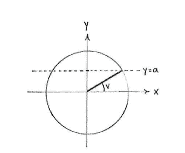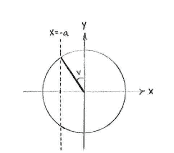Lösung 4.3:3e
Aus Online Mathematik Brückenkurs 1
(Unterschied zwischen Versionen)
K |
K (Robot: Automated text replacement (-{{Displayed math +{{Abgesetzte Formel)) |
||
| Zeile 1: | Zeile 1: | ||
The angle <math>\pi/2+v</math> makes the same angle with the positive ''y''-axis as the angle ''v'' makes with the positive ''x''-axis, and hence we see that the ''x''-coordinate for <math>\pi/2+v</math> is equal to the ''y''-coordinate for ''v'', but with a change of sign, i.e. | The angle <math>\pi/2+v</math> makes the same angle with the positive ''y''-axis as the angle ''v'' makes with the positive ''x''-axis, and hence we see that the ''x''-coordinate for <math>\pi/2+v</math> is equal to the ''y''-coordinate for ''v'', but with a change of sign, i.e. | ||
| - | {{ | + | {{Abgesetzte Formel||<math>\cos \Bigl(\frac{\pi}{2}+v\Bigr) = -\sin v = -a\,\textrm{.}</math>}} |
{| align="center" | {| align="center" | ||
Version vom 08:54, 22. Okt. 2008
The angle \displaystyle \pi/2+v makes the same angle with the positive y-axis as the angle v makes with the positive x-axis, and hence we see that the x-coordinate for \displaystyle \pi/2+v is equal to the y-coordinate for v, but with a change of sign, i.e.
| \displaystyle \cos \Bigl(\frac{\pi}{2}+v\Bigr) = -\sin v = -a\,\textrm{.} |
| Angle v | Angle π/2 + v |


